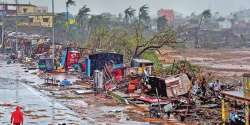How are Cyclones named | Explained in 10 points
It is not surprising if you are fascinated by the names of cyclones, and that definitely leaves you wondering about the process and concept behind naming them. Although however fascinating they may sound, you must remember they are lethal and bring with them violent winds, heavy rains and most of all, destruction. We'll explain the process of naming cyclones in 10 points. Here you go:

It is not surprising if you are fascinated by the names of cyclones, and that definitely leaves you wondering about the process and concept behind naming them. Although however fascinating they may sound, you must remember they are lethal and bring with them violent winds, heavy rains and most of all, destruction.
We'll explain the process of naming cyclones in 10 points. Here you go:1. It was at the World Meteorological Organisation/Economic and Social Commission for Asia and the Pacific Panel on Tropical Cyclones in 2000 when assigning names to the tropical cyclones in the Bay of Bengal and Arabian Sea, was agreed upon.
2. After long deliberations among the member countries at the twenty-seventh session in Muscat, the naming of tropical cyclones over north Indian Ocean commenced from September 2004.
3. Eight nations along the Bay of Bengal and Arabian Sea suggest names that are sequentially listed. The nations suggest names alphabetically -- Bangladesh, India, Maldives, Myanmar, Oman, Pakistan, Sri Lanka and Thailand. All contributed a set of names which are assigned sequentially whenever a cyclonic storm develops.
4. Some of the cyclone names suggested by India include Agni, Akash, Bijli, Jal, Leher, Megh, Sagar, Vayu. Pakistan, on the other hand, suggested Nilofar, Titli, Bulbul, Nilam. Mahasen, Murjan, Phailin are among those suggested by other countries. Of the 64 names suggested by the eight member countries, 57-58 have been utilised.
5. These lists are used sequentially and are not rotated every few years, unlike the Atlantic and Eastern Pacific lists. According to a report, a storm causes so much death and destruction that its name is considered for retirement and therefore is not used repeatedly.
6. According to a circular, if the public wants to suggest the name of a cyclone to be included in the list, the proposed name must meet some fundamental criteria. It said the name must be short and readily understood when broadcast. Also, they should not be culturally sensitive and must not convey unintended potentially inflamatory meaning. The names can be communicated to the Director General of the IMD.
7. Initially, people living in the Carribbean Islands would name the storms after the saint of the day from the Roman Catholic liturgical calendar for the day on which the cyclone occurred.
8. This tradition went on till World War II when forecasters and meteorologists started using female names to identify the storms.
9. It was in 1953 when the US weather service officially adopted the idea and created a new phonetic alphabet of women's names from A to W, leaving out Q,U,X,Y and Z.
10. It was only after women's liberation bodies protested in the 60s and 70s that helped change the naming procedure for the storms to include male names in 1978.
